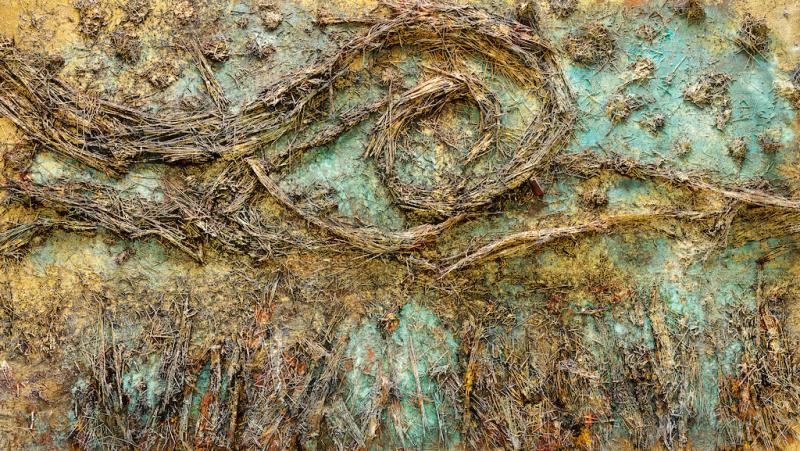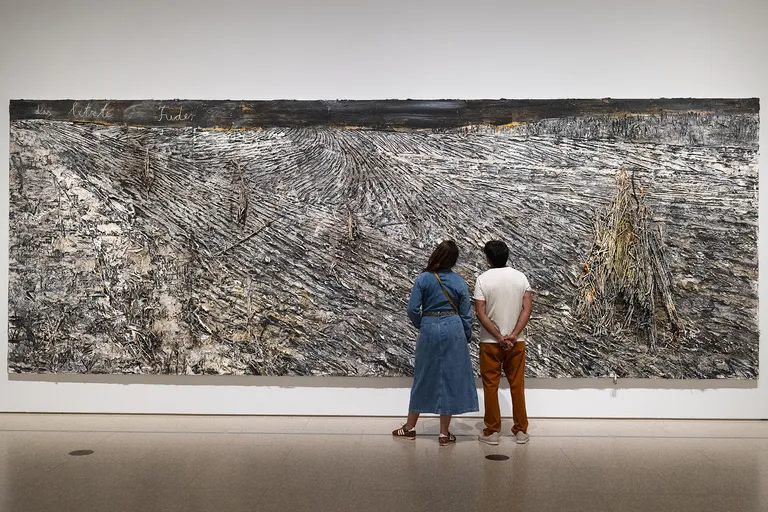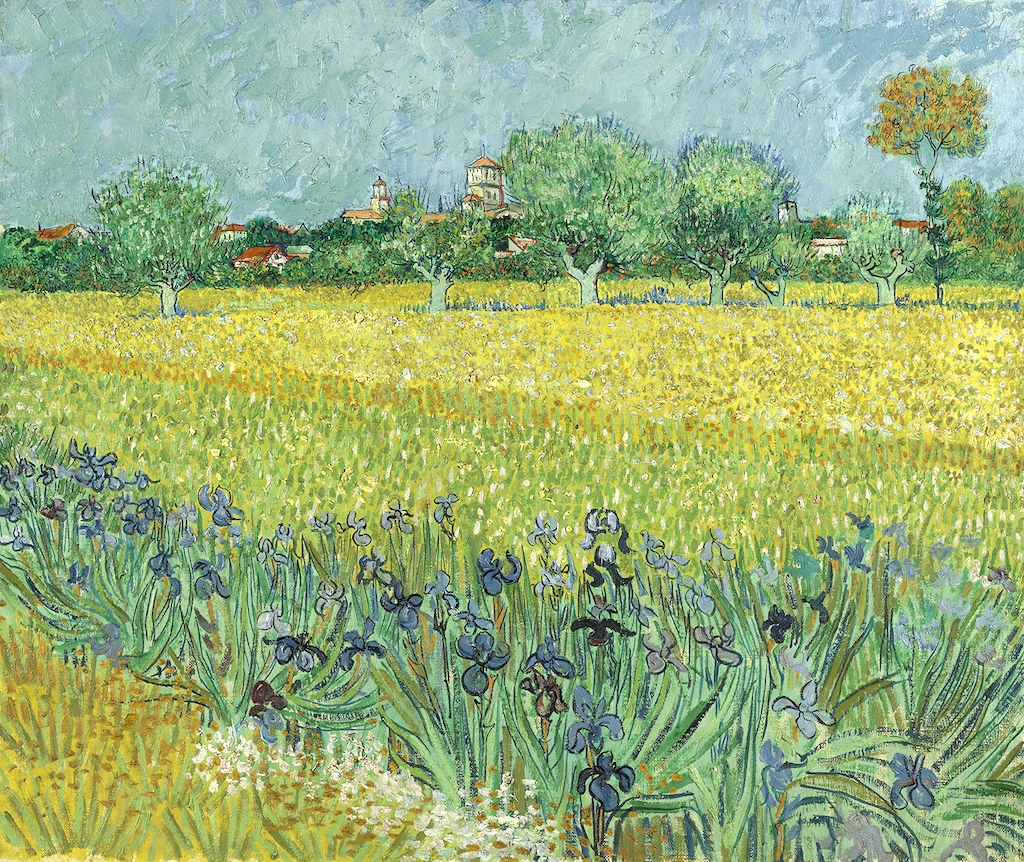Kiefer / Van Gogh, Royal Academy review - a pairing of opposites | reviews, news & interviews
Kiefer / Van Gogh, Royal Academy review - a pairing of opposites
Kiefer / Van Gogh, Royal Academy review - a pairing of opposites
Small scale intensity meets large scale melodrama

When he was a callow youth of 18, German artist Anselm Keifer got a travel grant to follow in the footsteps of his idol, Vincent van Gogh. Some sixty years later, work by the two artists has been brought together at the Royal Academy in a show that highlights Van Gogh’s influence on his acolyte and invites you to compare and contrast.
In the intervening years, Keifer has gained a huge international reputation with gargantuan paintings, sculptures and installations. His obsession with Van Gogh led him, in 1992, to move to the south of France where he transformed a former silk factory and the surrounding 40 hectare estate into a vast art installation. He is like the Wagner of visual arts – nearly everything is on a vast scale. And people tend to love or loathe the scope of his ambition, seeing it as either deeply meaningful or pretentiously overblown. This show may well flip you from one camp to the other. Keifer tries to match Van Gogh’s level of intensity by upping the ante. Take his version of Van Gogh’s The Starry Night, 1889, for example (main picture). Glued onto an enormous canvas, swathes of straw are wound into an eye-shaped swirl that imitates the cosmic turbulence of the original. Straw blobs stand in for stars and, perhaps aware that straw does not readily conjure the radiance of starlight or evoke a heightened sense of ecstasy, Keifer adds some gold leaf to the mix. Whereas van Gogh evokes a world made unstable by ecstatic inner turmoil, Keifer’s remix is about as poetic as a cow pat flung into the sky.
Keifer tries to match Van Gogh’s level of intensity by upping the ante. Take his version of Van Gogh’s The Starry Night, 1889, for example (main picture). Glued onto an enormous canvas, swathes of straw are wound into an eye-shaped swirl that imitates the cosmic turbulence of the original. Straw blobs stand in for stars and, perhaps aware that straw does not readily conjure the radiance of starlight or evoke a heightened sense of ecstasy, Keifer adds some gold leaf to the mix. Whereas van Gogh evokes a world made unstable by ecstatic inner turmoil, Keifer’s remix is about as poetic as a cow pat flung into the sky.
Earthiness can sometimes be a strength, though. In the same gallery hangs The Last Load (Das letzte Fuder), 2019 (pictured above). A loan sheaf of corn stands sentinel over dark furrows devoid of any trace of life. The sky is black and the horizon line is so high it feels as if your nose is pressed into the lifeless soil. It’s a scene of devastation and, because Kiefer allows space for one’s own interpretation, it is also very moving.
Named after the Greek gods of love and death, Eros and Thanatos, 2013-19, addresses the twin forces that govern existence. This time, though, Kiefer hammers home the message by attaching the kind of scythe once used by farmers for harvesting grain and by the Grim Reaper for gleaning souls to an expanse of empty furrows gleaming only with gold leaf. And the result is dreadful kitsch.
 Comparing this banal concoction with Van Gogh’s joyous painting of a field of corn fringed with irises (pictured right) brings home the fact that whereas Van Gogh uses vibrant colour to celebrate life, Kiefer's ashen grey paintings reveal an obsession with death. The artists are like chalk and cheese; Van Gogh’s pictures are an outpouring of passion and their immediacy is palpable; Keifer, on the other hand, relies on drama to fill an aching void of melancholy that no amount of gold leaf can disguise.
Comparing this banal concoction with Van Gogh’s joyous painting of a field of corn fringed with irises (pictured right) brings home the fact that whereas Van Gogh uses vibrant colour to celebrate life, Kiefer's ashen grey paintings reveal an obsession with death. The artists are like chalk and cheese; Van Gogh’s pictures are an outpouring of passion and their immediacy is palpable; Keifer, on the other hand, relies on drama to fill an aching void of melancholy that no amount of gold leaf can disguise.
rating
Explore topics
Share this article
The future of Arts Journalism
You can stop theartsdesk.com closing!
We urgently need financing to survive. Our fundraising drive has thus far raised £49,000 but we need to reach £100,000 or we will be forced to close. Please contribute here: https://gofund.me/c3f6033d
And if you can forward this information to anyone who might assist, we’d be grateful.

Subscribe to theartsdesk.com
Thank you for continuing to read our work on theartsdesk.com. For unlimited access to every article in its entirety, including our archive of more than 15,000 pieces, we're asking for £5 per month or £40 per year. We feel it's a very good deal, and hope you do too.
To take a subscription now simply click here.
And if you're looking for that extra gift for a friend or family member, why not treat them to a theartsdesk.com gift subscription?
more Visual arts
 'We are bowled over!' Thank you for your messages of love and support
Much-appreciated words of commendation from readers and the cultural community
'We are bowled over!' Thank you for your messages of love and support
Much-appreciated words of commendation from readers and the cultural community
 Folkestone Triennial 2025 - landscape, seascape, art lovers' escape
Locally rooted festival brings home many but not all global concerns
Folkestone Triennial 2025 - landscape, seascape, art lovers' escape
Locally rooted festival brings home many but not all global concerns
 Sir Brian Clarke (1953-2025) - a personal tribute
Remembering an artist with a gift for the transcendent
Sir Brian Clarke (1953-2025) - a personal tribute
Remembering an artist with a gift for the transcendent
 Emily Kam Kngwarray, Tate Modern review - glimpses of another world
Pictures that are an affirmation of belonging
Emily Kam Kngwarray, Tate Modern review - glimpses of another world
Pictures that are an affirmation of belonging
 Kiefer / Van Gogh, Royal Academy review - a pairing of opposites
Small scale intensity meets large scale melodrama
Kiefer / Van Gogh, Royal Academy review - a pairing of opposites
Small scale intensity meets large scale melodrama
 Jenny Saville: The Anatomy of Painting, National Portrait Gallery review - a protégé losing her way
A brilliant painter in search of a worthwhile subject
Jenny Saville: The Anatomy of Painting, National Portrait Gallery review - a protégé losing her way
A brilliant painter in search of a worthwhile subject
 Abstract Erotic, Courtauld Gallery review - sculpture that is sensuous, funny and subversive
Testing the boundaries of good taste, and winning
Abstract Erotic, Courtauld Gallery review - sculpture that is sensuous, funny and subversive
Testing the boundaries of good taste, and winning
 Edward Burra, Tate Britain review - watercolour made mainstream
Social satire with a nasty bite
Edward Burra, Tate Britain review - watercolour made mainstream
Social satire with a nasty bite
 Ithell Colquhoun, Tate Britain review - revelations of a weird and wonderful world
Emanations from the unconscious
Ithell Colquhoun, Tate Britain review - revelations of a weird and wonderful world
Emanations from the unconscious
 Rachel Jones: Gated Canyons, Dulwich Picture Gallery review - teeth with a real bite
Mouths have never looked so good
Rachel Jones: Gated Canyons, Dulwich Picture Gallery review - teeth with a real bite
Mouths have never looked so good
 Yoshitomo Nara, Hayward Gallery review - sickeningly cute kids
How to make millions out of kitsch
Yoshitomo Nara, Hayward Gallery review - sickeningly cute kids
How to make millions out of kitsch
 Hamad Butt: Apprehensions, Whitechapel Gallery review - cool, calm and potentially lethal
The YBA who didn’t have time to become a household name
Hamad Butt: Apprehensions, Whitechapel Gallery review - cool, calm and potentially lethal
The YBA who didn’t have time to become a household name

Add comment